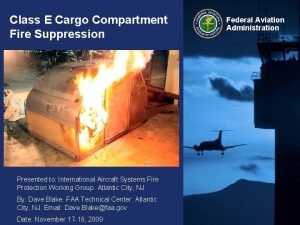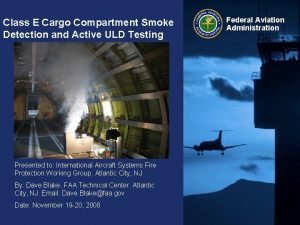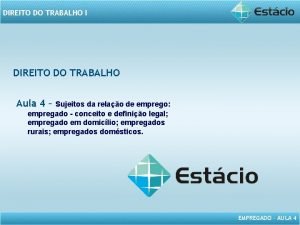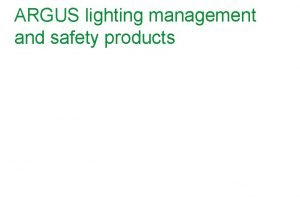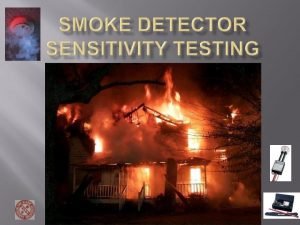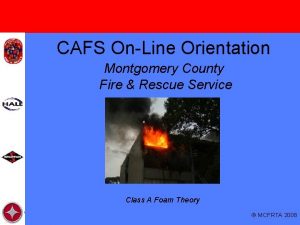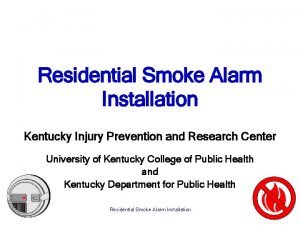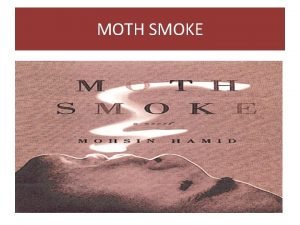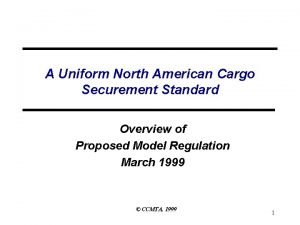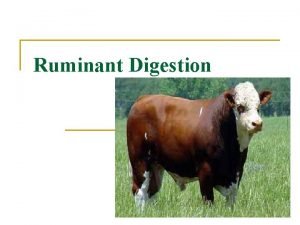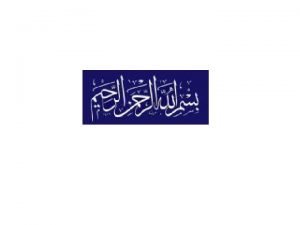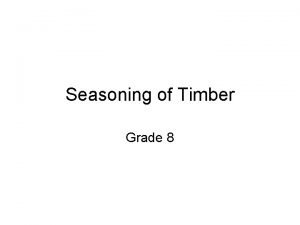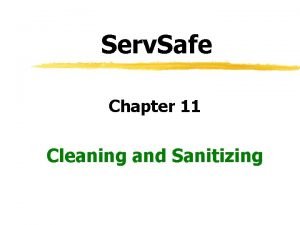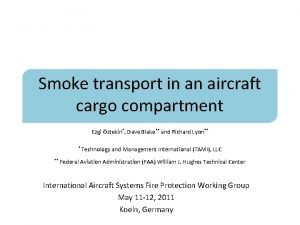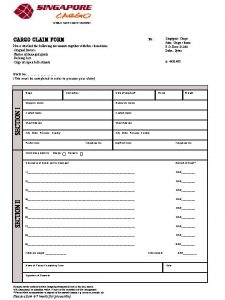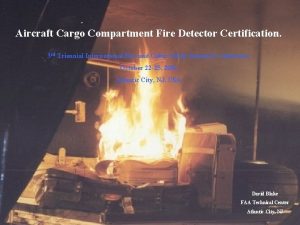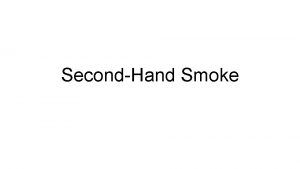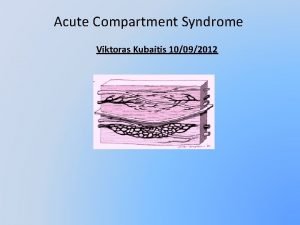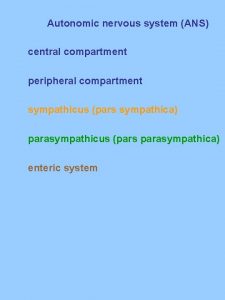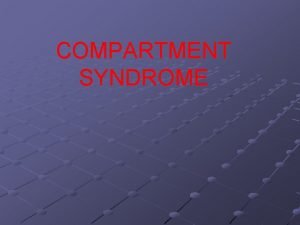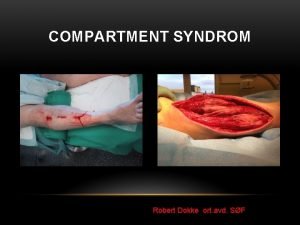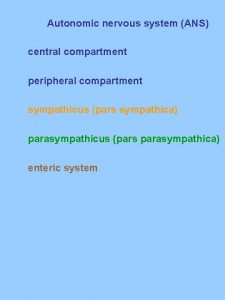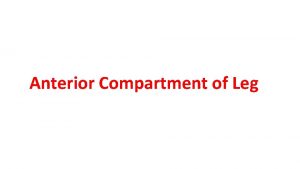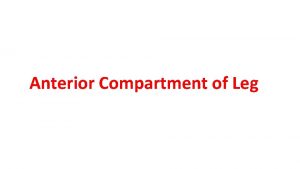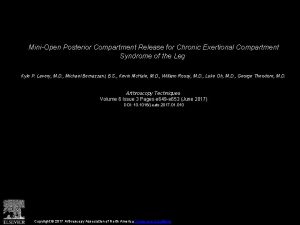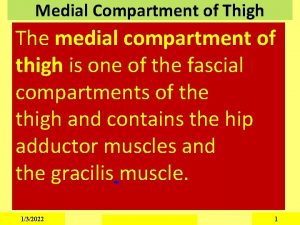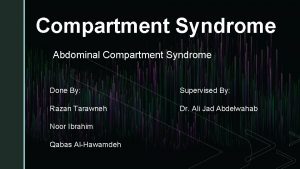CARGO COMPARTMENT SMOKE DETECTOR STANDARD AS 8036 UPDATE
















- Slides: 16

CARGO COMPARTMENT SMOKE DETECTOR STANDARD AS 8036 UPDATE Ken Bell, Kidde

INTRODUCTION FAA Approached SAE to update the AS 8036 Standard to include nuisance tests TSO C 1, Cargo Compartment Fire Detection Instruments calls out AS 8036 Hasn’t been updated since 1985 Has no requirements for minimum performance for false alarms resistance Working group was put together in April/May 2011 to update the document to Reflect current test standards Improve false alarm resistance of new designs This presentation will detail the changes to the standard

WORKING GROUP FROM THE FAA, SAE, BOEING, AIRBUS AND SMOKE DETECTOR MANUFACTURERS Keely Andrews Ken Bell Dave Blake Ian Campbell Laura Feix Andre Freiling Loic Frere SAE Kidde FAA Tech Center Meggitt SAE Airbus Siemens Stephen Happenny Joan Hughson Larry Lamberth Bruce Mahone Bruce Miller Gerd Wedler Ulrich Wollenweber, FAA Honeywell SAE Boeing AOA-Gauteng AOA Gauteng

CARGO FALSE ALARMS

UPDATES MADE TO AS 8036 FOR STANDARD ENVIRONMENTS DO-160 G called out for the following environments, where appropriate Temperature Altitude Decompression Overpressure Temperature Variation Humidity Shock Vibration Explosion proofness Waterproofness Fluids Susceptibility Sand Dust Fungus Resistance Salt Spray Magnetic Effect Power Input Voltage Spike Audio Frequency Conducted Susceptibility Induced Signal Susceptibility Radio Frequency Susceptibility (Radiated and Conducted) Emission of Radio Frequency Energy Lightning Induced Transient Susceptibility Lightning Direct Effects Icing Electrostatic Discharge Fire, Flammability

TESTS ADDED TO AS 8036 Smoke detection performance testing False alarm resistance against airborne dusts False alarm resistance against insecticide aerosol False alarm resistance against intense ambient light False alarm resistance against fog - combined environments

FIRE DETECTION TESTING Test fires from UL 268 or EN 54 -7 shall be selected to demonstrate that the detector can successfully detect fire UL 268 test fires EN 54 -7 test fires Test B (Wood Fire) TF 2 (Smouldering Wood Fire) Test C (Flammable Liquid Fire) TF 5 (Flaming Liquid).

FALSE ALARM TESTING - DUSTS No alarm shall occur as a result of normal dust present at instrument location, nor from dust that normally accumulates within the instrument. No false pre-flight system test indication shall occur due to accumulated dust. When subjected to dust aerosolized in test equipment similar to the description in Figure 1, the instrument must not suffer a false alarm and operate electrically and/or mechanically, where appropriate. The dust test shall be performed 2 times, at different rates of rise for the dust concentration. 1. A rate of rise of approximately 0. 4%/ft/min (1. 31%/m/min) shall be used 2. A rate of rise of approximately 3. 4%/ft/min (10. 72%/m/min) shall be used For the dust testing the minimum test concentration shall be at least 7%/ft (21. 2%/m). The average test concentration shall be maintained for at least one minute. For detectors calibrated to alarm at a smoke level X (where X ≤ 5%/ft (15. 5%/m)) obscuration, the detector shall not alarm when subjected to a minimum test dust concentration of 7%/ft (21. 2%/m). For detectors calibrated to alarm at a smoke level Y (where Y > 5%/ft (15. 5%/m)) obscuration, the detector shall not alarm when subjected to a minimum test dust concentration of Y + 2 %/ft (6. 4%/m). The test shall be repeated 3 times. All consecutive tests shall be passed.

DUST TESTING APPARATUS

FALSE ALARM TESTING - INSECTICIDE No alarm shall occur as a result of insecticide aerosol present at instrument location. When subjected to insecticide aerosol in test equipment described in Figures 2 and 3, the instrument must not suffer a false alarm and operate electrically and/or mechanically, where appropriate. The insecticide test shall be performed 2 times, at different rates of rise for the insecticide concentration. 1. A rate of rise of approximately 0. 4%/ft/min (1. 31%/m/min) shall be used 2. A rate of rise of approximately 3. 4%/ft/min (10. 72%/m/min) shall be used For the insecticide testing the minimum test concentration shall be at least 7%/ft (21. 2%/m) to be verified by a reference measurement device. The average test concentration shall be maintained for at least one minute. The test aerosol may be generated by use of a pressurized insecticide aerosol such as Callington One-Shot or equivalent. For detectors calibrated to alarm at a smoke level X (where X ≤ 5%/ft (15. 5%/m)) obscuration, the detector shall not alarm when subjected to a minimum test insecticide concentration of 7%/ft. For detectors calibrated to alarm at a smoke level Y (where Y > 5%/ft (15. 5%/m)) obscuration, the detector shall not alarm when subjected to a minimum test insecticide concentration of Y + 2 %/ft (6. 4%/m). The test shall be repeated 3 times. All consecutive tests shall be passed.

INSECTICIDE TESTING APPARATUS

AMBIENT LIGHT TESTING No alarm shall occur as a result of ambient light being directed at the detector The detector shall be subjected to a dazzle test using a cube of side approximately 13. 8” (350 mm) The internal surfaces of the cube shall be lined with high gloss aluminum foil Five 32 W circular fluorescent lamps of diameter approximately 12. 3” (312 mm) are fixed to the bottom face and the sides With the test unit operating and mounted to the inside of the top face, no false alarms shall be reported when all lamps are activated An alternate test would be the EN 54 -7 paragraph 5. 7 dazzle test

AMBIENT LIGHT TESTING APPARATUS

COMBINED ENVIRONMENTS TEST Designed to simulate cycling between hot humid airports and cold dry cruise Bring the environment to Warm/Moist. With the test item operating, ramp the humidity to 95 percent relative humidity (RH) at an average 6%/min. Ramp the temperature to 50 o. C at a rate of 5 o. C per minute Warm/Moist Dwell. Maintain 50°C, site pressure, and 95 percent relative humidity for 30 minutes Ramp to Cold Altitude. With the test item operating, ramp the temperature to 0 o. C at a rate of 5 o. C per minute. Ramp the humidity to ambient conditions at an average ramp rate of 6% RH/min. Ramp the chamber from the test site pressure to 15000 ft pressure altitude Cold Soak. Allow the test item to soak at 0 o. C, 15000 ft and uncontrolled humidity for 1 hour Repeat the cycle (steps 1 to 4) two (2) times Bring to ambient conditions

Time 0 48 0 47 0 43 5 41 5 40 5 34 0 33 0 32 0 29 5 27 5 26 5 20 0 19 0 18 0 15 5 13 5 12 65 50 40 10 0 T (o. C)/RH (% RH)/P (PSIA) COMBINED ENVIRONMENTS T, P & RH TEST PROFILES 100 90 80 70 60 50 P 40 T RH 30 20 10 0

SUMMARY AS 8036 updated and new Revision agreed by the AS 8036 working group Document is with the SAE Aerospace Council for review and 28 day ballot If no disapprovals it will be sent to publish TSO C 1 e will subsequently be updated to call out the new standard
 Class e cargo compartment
Class e cargo compartment Class e cargo compartment
Class e cargo compartment Lei 8036/90
Lei 8036/90 Marcelo jose ferlin d'ambroso
Marcelo jose ferlin d'ambroso Argus lighting
Argus lighting Walter jaeger smoke detector
Walter jaeger smoke detector Smoke detector repair montgomery county
Smoke detector repair montgomery county Smoke detector mounting tape
Smoke detector mounting tape Moth smoke sparknotes
Moth smoke sparknotes Database backup and recovery techniques
Database backup and recovery techniques Who maintains the north american cargo securement standard
Who maintains the north american cargo securement standard What animal is this
What animal is this Peritoneal cavity meaning
Peritoneal cavity meaning Superficial peroneal nerve supplies
Superficial peroneal nerve supplies Advantages and disadvantages of air seasoning
Advantages and disadvantages of air seasoning What is cleaning servsafe
What is cleaning servsafe Principles of bag techniques
Principles of bag techniques
